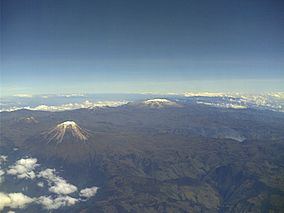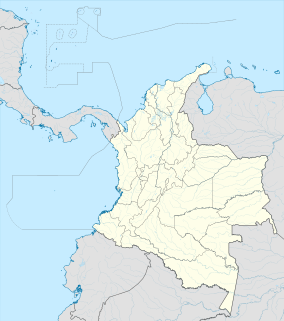Los Nevados National Natural Park facts for kids
Quick facts for kids Los Nevados National Natural Park |
|
|---|---|
| Parque Nacional Natural Los Nevados | |
|
IUCN Category II (National Park)
|
|

Aerial view of Los Nevados National Park
|
|
| Location | Caldas, Risaralda, Quindío and Tolima, Colombia |
| Nearest city | Armenia - Ibagué - Manizales - Pereira |
| Area | 58,300 hectares (225 sq mi) |
| Established | 1973 |
| Visitors | 39,904 (in 2016) |
| Governing body | SINAP |
| Website | |
Los Nevados National Natural Park (which means Snowy Peaks National Natural Park in Spanish) is a special protected area in the Central Mountain Range of the Colombian Andes. This park is famous for its tall, snowy volcanoes. It surrounds a group of volcanoes in the north, including Nevado del Ruiz, Nevado del Tolima, and Nevado de Santa Isabel. It also includes smaller mountain areas like the paramillos of Cisne, Santa Rosa, and Quindío, plus the Cerro Bravo and Cerro Machín mountains.
The park is spread across several areas in Colombia. These include the departments of Caldas, Quindío, Risaralda, and Tolima. Many towns are near the park, such as Manizales, Pereira, and Ibagué.
Contents
Park Safety and Volcano Activity
The park has been closed by authorities since March 31, 2023. This is because the Nevado del Ruiz Volcano has become more active. There are worries about a possible eruption.
Because of the volcano's activity, the park is currently closed to visitors. It is very important for anyone planning a visit to check the latest updates. You can find this information on the Colombian Geological Survey's website. This helps everyone stay safe.
How the Park Was Formed
The landscape of Los Nevados National Natural Park has been shaped by glaciers. These huge ice sheets have carved out the land over thousands of years. You can see U-shaped valleys and piles of rock called moraines, which were left behind by the glaciers.
The park also has many rocks formed from volcanoes. These rocks are common at higher elevations. Inside the park, you can find beautiful lakes. Otún Lake is special because it sits in the crater of an old, inactive volcano. There is also the Green Lake.
Water Sources and Rivers
This protected area is very important for water. Many rivers and streams begin here. The park's glaciers cover about 4% of the area. These glaciers are found on the three main volcanoes: Nevado del Ruiz, Nevado de Santa Isabel, and Nevado del Tolima.
When the glaciers melt, their water feeds many rivers. These rivers form 10 large river systems and 19 smaller streams. Six of these river systems flow into the Magdalena River. The other four flow into the Cauca River.
The water from the park helps over 2,000,000 people in the region. It also provides water for coffee farms and for growing rice and cotton in the Tolima Department. The Otún wetland system within the park is so important that it is recognized internationally. It is protected under the Ramsar Convention.
Glaciers Are Shrinking
Scientists have noticed that the ice caps on the park's snowy mountains are melting. This is a big concern. For example, the "Ice Cathedrals" used to be huge ice caves inside the Nevado del Ruiz glacier. They were popular with climbers before 1995 but have now disappeared.
At the end of the 1800s, there were six glaciers in the park. They were on the peaks of El Ruiz, Santa Isabel, Tolima, El Cisne, Quindío, and Paramillo de Santa Rosa. These glaciers were located at about 4,500 meters (14,760 feet) above sea level.
The melting of these glaciers has gotten worse since the mid-1900s. Now, only three glaciers remain: El Nevado del Ruiz, Nevado de Santa Isabel, and Nevado de Tolima. The other three completely melted by the late 1970s. The remaining glaciers are still shrinking. The situation is critical for Nevado del Tolima and Santa Isabel. Their ice areas are very small. Scientists expect these two glaciers to disappear completely between 2030 and 2040.
Plants and Animals of the Park
Los Nevados National Natural Park has many different types of environments. These environments change as you go higher up the mountains. The lower parts of the park have Andean forests and high Andean wetlands. The higher parts have special areas called páramo and super-páramo.
The páramo is a unique grassland area. It also has bogs, bushes, swamps, and lagoons. This type of environment covers 80% of the park. The super-páramo is even higher up. It looks a bit like the moon, with rocks, ash, and very few plants.
Park Flora: Amazing Plants
The park is home to many plant species. There are 1,250 types of vascular plants (plants with roots, stems, and leaves). You can also find 200 types of bryophytes (like mosses), 300 types of lichens, and 180 types of large fungi.
In the lower areas and valleys, you will see tall wax palms. These are the national tree of Colombia. The upper Andean forest has trees that can grow up to 30 m (98 ft) (about 100 feet) tall. In the páramo, tall plants called frailejones are common. You can also see many mosses and lichens. The lagoons sometimes have colorful algae.
Park Fauna: Wonderful Animals
The park is a home for many interesting animals.
- Birds: You might spot the blue-crowned motmot, yellow-eared parrot, or the Andean condor. The buffy helmetcrest hummingbird is very special. It is only found in this region.
- Mammals: Some mammals living here include the mountain tapir, the spectacled bear, and the northern pudú (a tiny deer). You might also see an oncilla (a small wild cat), a cougar, or a white-eared opossum.
See also
 In Spanish: Parque nacional natural Los Nevados para niños
In Spanish: Parque nacional natural Los Nevados para niños







